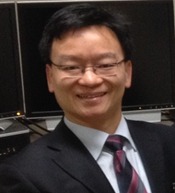Program Information
Multi-Energy CT: Current Status and Recent Innovations

N Pelc
C McCollough
L Yu
T Schmidt
N Pelc1*, C McCollough2*, L Yu3*, T Schmidt4*, (1) Stanford University, Stanford, CA, (2) Mayo Clinic, Rochester, MN, (3) Mayo Clinic, Rochester, MN, (4) Marquette University, Milwaukee, WI
Presentations
WE-E-18C-1 Wednesday 1:45PM - 3:45PM Room: 18CConventional computed tomography (CT) uses a single polychromatic x-ray spectrum and energy integrating detectors, and produces images whose contrast depends on the effective attenuation coefficient of the broad spectrum beam. This can introduce errors from beam hardening and does not produce the optimal contrast-to-noise ratio. In addition, multiple materials can have the same effective attenuation coefficient, causing different materials to be indistinguishable in conventional CT images.
If transmission measurements at two or more energies are obtained, even with polychromatic beams, more specific information about the object can be obtained. If the object does not contain materials with k-edges in the spectrum, the x-ray attenuation can be well-approximated by a linear combination of two processes (photoelectric absorption and Compton scattering) or, equivalently, two basis materials. For such cases, two spectral measurements suffice, although additional measurements can provide higher precision. If K-edge materials are present, additional spectral measurements can allow these materials to be isolated.
Current commercial implementations use varied approaches, including two sources operating a different kVp, one source whose kVp is rapidly switched in a single scan, and a dual layer detector that can provide spectral information in every reading. Processing of the spectral information can be performed in the raw data domain or in the image domain. The process of calculating the amount of the two basis functions implicitly corrects for beam hardening and therefore can lead to improvements in quantitative accuracy. Information can be extracted to provide material specific information beyond that of conventional CT. This additional information has been shown to be important in several clinical applications, and can also lead to more efficient clinical protocols.
Recent innovations in x-ray sources, detectors, and systems have made multi-energy CT much more practical and improved its performance. In addition, this is a very active area of research and further improvements are expected through further technological improvements.
Learning Objectives:
1. basic principles of multi-energy CT
2. current implementations of mutli-energy CT
3. data and image analysis methods in multi-energy CT
4. current clinical applications of dual energy CT
5. recent innovations and anticipated advances in multi-energy CT
Handouts
- 90-25316-339462-103189.pdf (N Pelc)
- 90-25317-339462-103116.pdf (C McCollough)
- 90-25318-339462-102621.pdf (L Yu)
- 90-25319-339462-103251.pdf (T Schmidt)
Contact Email:






